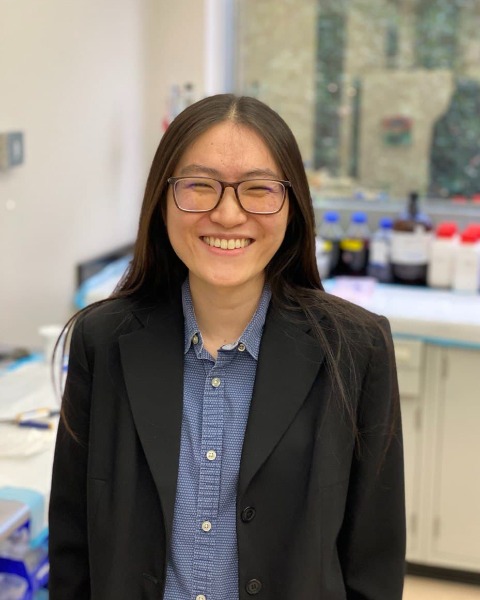Tissue Engineering
(M-489) Reverse engineered three-dimensional tissue-engineered arteriole model
Friday, October 13, 2023
3:30 PM - 4:30 PM PDT
Location: Exhibit Hall - Row M - Poster # 489

Lily Liang (she/her/hers)
Phd Student
Johns Hopkins University
Owings Mills, Maryland, United States- PS
Peter Searson
Professor
Johns Hopkins University
BALTIMORE, Maryland, United States
Presenting Author(s)
Primary Investigator(s)
Introduction:: This study reports the generation of a generic 3D tissue engineered arteriole model for health and disease modeling. Using a template-based approach to create an extracellular matrix environment around the vessel channel, smooth muscle and endothelial cells were subsequentially seeded to create a double monolayer blood vessel that mimics an arteriole. Smooth muscle cell maintenance protocols were tested and optimized to overcome technical challenges of arteriole model fabrication. The arteriole vessel demonstrates paracellular barrier function expected of in vitro endothelial cell only microvessels.
Materials and Methods:: A microfluidic device was constructed by adhering coverslips to a 3D printed housing using double sided adhesive. A cylindrical channel was formed in a hydrogel environment by needle templating using a 150 µm diameter nitinol wire and collagen I titrated to pH 9 and incubated at 37 ℃ for 10 minutes. The arteriole was constructed by first seeding human brain primary smooth muscle cells (SMCs) into the empty hydrogel channel until a confluent monolayer was well adhered. The microfluidic device was then perfused using 2000 Pa pressure head with a resistance limiter to ensure a maximum 0.5 mL h-1 flow rate. After 7 days of SMC vessel maintenance, Veravec-GFPs, a GFP-expressing human umbilical vein endothelial cell line (EC), were seeded on top of the SMC monolayer until a distinct second monolayer of endothelial cells were adhered (Fig. A, B). Paracellular permeability of the arteriole model was measured using 2 MDa and 70 kDa fluorescently labeled dextrans to determine vessel barrier function two days after EC seeding (Fig. F).
Results, Conclusions, and Discussions:: Results and Discussion: To determine optimal cell maintenance and perfusion parameters for SMC vessel culture, both 400 Pa and 2000 Pa pressure heads were tested and perfusion flow rates measured (Fig. C). The SMCs tended to overproliferate in sections of the vessel over time at 400 Pa pressure as measured by change in vessel lumen diameter at different sections along the length of the vessel (Fig. D, E). The SMC vessels were then matured for either 1, 3, or 7 days under 2000 Pa pressure to determine optimal time length of SMC vessel culture to maximize EC adherence to the SMCs (Fig. F). The fractional area of EC adhesion on the SMC monolayer was measured one day after EC seeding using thresholding in ImageJ (Fig. G). The functional barrier property of the arteriole model was determined to be similar to EC only vessels, suggesting complete maturation of the arteriole model (Fig. H, I).
Conclusions: This study presents the fabrication of a tissue engineered arteriole model with physical architecture and functional characteristics like human arterioles. Key technical challenges overcome include SMC overproliferation and maturation for subsequent EC seeding. In the future, we expect the model may be used to create brain specific arterioles for neurodegenerative disease modeling using iPSC-derived cell lines.
Acknowledgements (Optional): : This material is based upon work supported by the National Science Foundation Graduate Research Fellowship under Grant No. DGE2139757.
References (Optional): :
Materials and Methods:: A microfluidic device was constructed by adhering coverslips to a 3D printed housing using double sided adhesive. A cylindrical channel was formed in a hydrogel environment by needle templating using a 150 µm diameter nitinol wire and collagen I titrated to pH 9 and incubated at 37 ℃ for 10 minutes. The arteriole was constructed by first seeding human brain primary smooth muscle cells (SMCs) into the empty hydrogel channel until a confluent monolayer was well adhered. The microfluidic device was then perfused using 2000 Pa pressure head with a resistance limiter to ensure a maximum 0.5 mL h-1 flow rate. After 7 days of SMC vessel maintenance, Veravec-GFPs, a GFP-expressing human umbilical vein endothelial cell line (EC), were seeded on top of the SMC monolayer until a distinct second monolayer of endothelial cells were adhered (Fig. A, B). Paracellular permeability of the arteriole model was measured using 2 MDa and 70 kDa fluorescently labeled dextrans to determine vessel barrier function two days after EC seeding (Fig. F).
Results, Conclusions, and Discussions:: Results and Discussion: To determine optimal cell maintenance and perfusion parameters for SMC vessel culture, both 400 Pa and 2000 Pa pressure heads were tested and perfusion flow rates measured (Fig. C). The SMCs tended to overproliferate in sections of the vessel over time at 400 Pa pressure as measured by change in vessel lumen diameter at different sections along the length of the vessel (Fig. D, E). The SMC vessels were then matured for either 1, 3, or 7 days under 2000 Pa pressure to determine optimal time length of SMC vessel culture to maximize EC adherence to the SMCs (Fig. F). The fractional area of EC adhesion on the SMC monolayer was measured one day after EC seeding using thresholding in ImageJ (Fig. G). The functional barrier property of the arteriole model was determined to be similar to EC only vessels, suggesting complete maturation of the arteriole model (Fig. H, I).
Conclusions: This study presents the fabrication of a tissue engineered arteriole model with physical architecture and functional characteristics like human arterioles. Key technical challenges overcome include SMC overproliferation and maturation for subsequent EC seeding. In the future, we expect the model may be used to create brain specific arterioles for neurodegenerative disease modeling using iPSC-derived cell lines.
Acknowledgements (Optional): : This material is based upon work supported by the National Science Foundation Graduate Research Fellowship under Grant No. DGE2139757.
References (Optional): :
